Move It!
Is Exercise Enough?
 Studies have shown that exercise during space missions or bed rest was useful, but rarely was it more than 50% effective in keeping muscles and bones from wasting.
Studies have shown that exercise during space missions or bed rest was useful, but rarely was it more than 50% effective in keeping muscles and bones from wasting.
NASA confirmed that the determining factor in the ability to withstand and respond to unusual challenges is not chronological age. John Glenn, a very fit 77-year old in a mission in 1998, showed that the critical factor is a healthy and active a lifestyle.
This is not isolated to seniors! How many workers sit at a computer all day, students sit at desks all day, children sit playing video games or texting? Maybe we go work out, but continue to be sedentary on relaxation time at home?
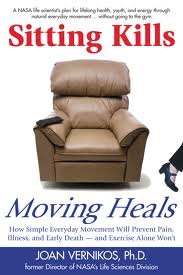 Inactivity, too much sitting, is a risk factor for obesity, type 2 diabetes, and other illnesses. Standard exercise you get at the gym will not get to the root of keeping you healthy. It is non-exercise activity – small, brief, frequent muscular movements such as changing position – which is the key.
Inactivity, too much sitting, is a risk factor for obesity, type 2 diabetes, and other illnesses. Standard exercise you get at the gym will not get to the root of keeping you healthy. It is non-exercise activity – small, brief, frequent muscular movements such as changing position – which is the key.
Joan Vernikos, PhD, a NASA life scientist, has written a book documenting how simple everyday movement will prevent pain, illness, and early death – and exercise alone won’t. The startling title of the book is “Sitting Kills, Moving Heals.”
Non-exercise Activity
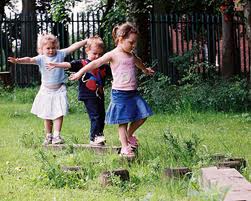 Unlimited opportunities for fitness are all around us. We had these habits as a growing child, and if you lost them, then it is time to get them back! I am talking about natural, habitual physical activity that we engage in every day, day after day, every day of our lives. Picture yourself in perpetual motion.
Unlimited opportunities for fitness are all around us. We had these habits as a growing child, and if you lost them, then it is time to get them back! I am talking about natural, habitual physical activity that we engage in every day, day after day, every day of our lives. Picture yourself in perpetual motion.
Postural muscles, which primarily maintain the body’s upright stance, are known as stabilizers. Muscles that move the body, most of which are target in a gym workout, are called mobilizers. Stabilizer muscles become weak faster when they no longer have to work against gravity. They rely on low and sustained effort to stay strong.
For optimal effectiveness, the intensity should be low. Gentle movements that challenge gravity, and all strength moves as well, specifically work on developing those precious maps in the brain that control balance and coordination.
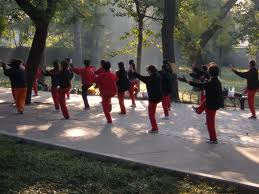 The focus on mobilizer muscle exercise can result in chronic pain, especially back pain. When stabilizers atrophy from a sedentary lifestyle, the stable base for mobilizers to work is lacking. Consequently, segments of the body become unstable, distorting movement and causing low back pain. This can also cause falls.
The focus on mobilizer muscle exercise can result in chronic pain, especially back pain. When stabilizers atrophy from a sedentary lifestyle, the stable base for mobilizers to work is lacking. Consequently, segments of the body become unstable, distorting movement and causing low back pain. This can also cause falls.
Ancient forms of activity like Tai Chi and Yoga mainly target stabilizer muscles. Maintaining the fitness of stabilizer muscles is the foundation of a healthy, active body. This happens with continuous low-intensity activities. So, throughout the day, repetitive, sustained, low-intensity activities will keep strong the stabilizer system.
Child’s Play
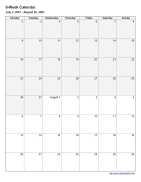 There is no end to the number and kind of new habits you could explore and develop. Eight to twelve weeks is a reasonable time frame to solidify new habits in your daily routine. Habits must be realistic and be congruent with your lifestyle.
There is no end to the number and kind of new habits you could explore and develop. Eight to twelve weeks is a reasonable time frame to solidify new habits in your daily routine. Habits must be realistic and be congruent with your lifestyle.
Devise some program you can live with for the rest of your life, one that does not cut into your time and energy. I will show you activities which are targeted and efficient, with a maximal response for minimal effort. We need to build in variety, practical choices, measurable success, rewards.
Eight fundamentals of Effective Activity
- posture and balance challenges for stabilizer muscles and brain,
- stretching movements for flexibility,
- strength-building movements for mobilizer muscles,
- as well as aerobic intensity for improving stamina and cardiovascular fitness.
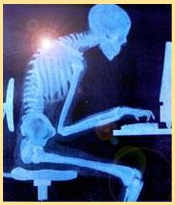 2. You need to do this All Day:
2. You need to do this All Day:
- Start by estimating how much time is spent sitting or lying down during the day.
- Aim to spend less time sitting or slouched.
3. Habits offering a range of high and low intensity activity helps keep the body tuned.
4. Develop habits of intermittent activity throughout the day. This is the same as interval training in exercise – alternating slow and fast bursts of movement.
5. Alternate hard and easy activity through the day instead of trying to sustain activity at the same level.
 6. Variety is essential because the body becomes less responsive to the same repeating movements.
6. Variety is essential because the body becomes less responsive to the same repeating movements.
7. The body has maximal gravity effect when it is standing. See if you can do most activities standing.
8. Doing activity with closed eyes enhances the influence of gravity.
Now Get Moving!
Stand Up Sit Down
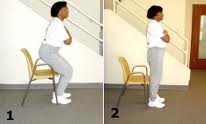 This is the single most important habit you can acquire. This is the key to independence in old age. You can maximize this by standing up slowly.
This is the single most important habit you can acquire. This is the key to independence in old age. You can maximize this by standing up slowly.
Watch how you get out of a chair. Do you lean on the arms of the chair? Do you lean on your knees? Leaning does strengthen the arms, but the next step is to stand up without leaning on anything.
Create opportunities to get up often. Get a glass of water. Do a happy dance.
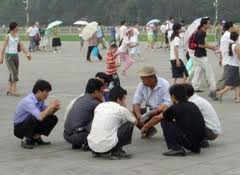 Sitting down goes way beyond just giving in to gravity. When you slow it down, you resist gravity and therefor strengthen your muscles. This is especially true if you maintain an erect posture.
Sitting down goes way beyond just giving in to gravity. When you slow it down, you resist gravity and therefor strengthen your muscles. This is especially true if you maintain an erect posture.
Squatting is the original sitting. Watch a young child do it, and remember when you could do it too. It is the most efficient position for bowel evacuation.
Holding a squat strengthens the large thigh muscles. Standing up from a squat is the ultimate in standing up – but most of us need to work into it gradually.
Stretch
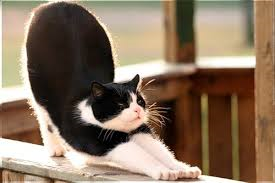 Watch a dog or cat for effective directions.
Watch a dog or cat for effective directions.
They do it just about every time they get up, for just a moment.
Think of your inner child and play with it.
Stand Tall
 Dropping the head forward reduces the spine’s work against gravity, weakening it. By practicing aligned posture, as if there was a string pulling you up from the top of your head, you strengthen the spine.
Dropping the head forward reduces the spine’s work against gravity, weakening it. By practicing aligned posture, as if there was a string pulling you up from the top of your head, you strengthen the spine.
To check your posture, stand with your back against a wall.
Then, check to see if you can slip your hand freely between your body and the wall. Although we have a set of curves in the spine, they should not be that extreme as a hand will fit behind you.
At Your Desk
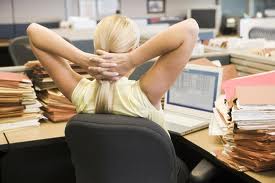 Keep the shoulder blades back so that the shoulders do not round and your head come forward. There are various stretches to do this, the easiest to simply clasp your hands behind your back.
Keep the shoulder blades back so that the shoulders do not round and your head come forward. There are various stretches to do this, the easiest to simply clasp your hands behind your back.
This hold true for sitting in an armchair. Rest your hands on your thigh to keep the shoulder blades back.
Take the Stairs
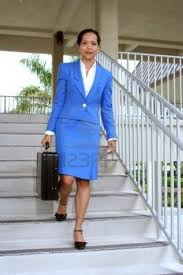 To ease into it, take the elevator or escalator up, then take the stairs down.
To ease into it, take the elevator or escalator up, then take the stairs down.
Going down has a balance component, going up requires stamina.
Aspire to descending stairs without looking at your feet or holding on to the rail. This helps strengthen bones more than walking, plus it helps stretch tendons.
Getting Dressed
 How do you put on and take off your shoes, socks, pants? Leaning or sitting?
How do you put on and take off your shoes, socks, pants? Leaning or sitting?
The ultimate is to do it standing, maintaining erect posture and lifting the foot up high. This builds balance.
When it becomes habit, add the challenge of repeating it with your eyes closed.
Balance an Object on Your Head
 Have you watched women in developing countries carrying water on their heads? Did you notice the erect spine, strong posture?
Have you watched women in developing countries carrying water on their heads? Did you notice the erect spine, strong posture?
You can start with a bean bag. Sitting working at the computer is a good start. Then you can progress to walking.
Dancing
Take a class, or just take a Boogie Break.
Everyday Habits
 Sweeping, vacuuming, taking out the garbage count as non-exercise movements.
Sweeping, vacuuming, taking out the garbage count as non-exercise movements.
So does gardening and yard work.
Consider hanging out your wash to dry.
Park away from an entrance and walk around to shop.
Go to fairs or festivals for entertainment instead of plopping down in front of the TV.
I would love to hear your comments below about how you incorporate movement into your daily life.
WANT TO USE THIS ARTICLE IN YOUR NEWSLETTER OR WEB SITE? You can, as long as you include this complete blurb with it:
“Naturopathic Physician Dr. Cheryl Kasdorf is a doctor who listens and has answers with a natural approach that works. She is known as the go-to person to get back your get-up-and-go when it is gone, gone, gone. Get your FREE gift “Dr. Kasdorf’s Health Secrets for Feeling & Looking Great” at drcherylkasdorf.com





